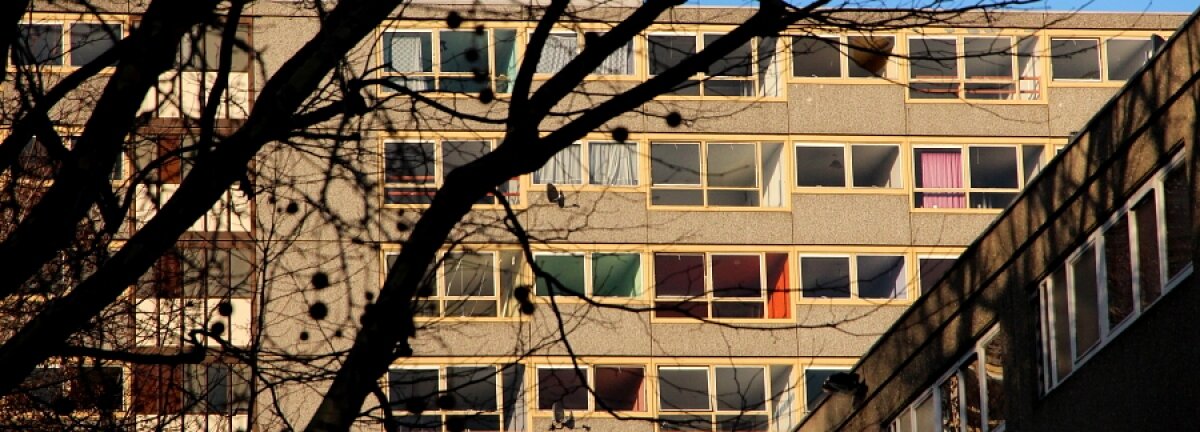In defence of... the Heygate Estate

Despite its reputation as a sink estate, the Heygate was a great example of council housing on large scale and one that could have enjoyed a second life.
I like 'ugly buildings'. They have an interesting story to tell about utopian visions, great expectations and a better future. I am intrigued that where others see an eyesore, I see a masterpiece.
Every day on my way to work, I pass what might be one of London’s most famous ugly buildings'. It is the notorious sink estate in Elephant & Castle: the Heygate. Awaiting demolition for a big redevelopment programme and abandoned by most of the residents, the estate has adopted a ghostly quality, boarded up and slowly crumbling apart (unsurprisingly it became the go-to setting for a number of dystopian films over recent years: Harry Brown, Attack the Block, World War Z). In fact, depending on when you’re reading this, it might already have vanished.
Can we afford to throw buildings away, given the amount of embodied energy and valuable resources they contain?
So before the wrecking ball finishes its destructive work, I’d like to do as the title suggests and defend some of the qualities often overlooked in the Heygate estate – qualities that have been overshadowed by its bad reputation. I’d like to pay my respects to the architecture and the aspirations that once defined this estate and the ‘new modern homes’ it provided for London.
Completed in 1974, the Heygate Estate was home to a community of 3000 residents. Walkways for pedestrians interconnected the buildings and provided a safe environment separated from the cars. Today, it’s startling to see how the visionary optimism of the post-war era and the trust in a better future turned stale and went awry. But try to ignore the run-down look of the Estate, the graffiti-covered garage doors, boarded-up windows and aborted walkways. Instead look at the large blocks that, in my mind, seem to float along the Walworth Road, like a majestic cruise ships, anchored to the pavement by concrete gangways that keep pedestrians and vehicles neatly separate.
Vegetation between the blocks and lower terraces gives the area an almost Arcadian quality. I am intrigued by the strong horizontal lines of the blocks and the simplicity of their design – I’m almost tempted to call them elegant. How splendid these flats must have been in the early days with their huge window fronts, lifts and central heating, rubbish chutes and fitted kitchens. They made the the old soot-covered Victorian terraces appear narrow, dingy and positively archaic. Many of those archaic Victorian homes were demolished at the time.
© Image Copyright:
The Londonist
Things change. Now, the Heygate is condemned and the surviving Victorian terraces fetch record prices. Regeneration is one of the great buzz words. The estate’s premium location, only two minutes away from a Zone 1 tube station, mean that property prices continue to explode. Tall buildings are sprouting out of the ground around Elephant & Castle, and the proposal for the Heygate redevelopment works well with this new image.
They made the the old soot-covered Victorian terraces appear narrow, dingy and positively archaic.
Stylistically and ideologically obsolete, these concrete examples of a bygone era are now under threat. Many have gone already. In addition to the social and economic aspects, the environmental argument is important too. Can we afford to throw those buildings away, given the amount of embodied energy and valuable resources they contain? Lacaton & Vassal’s reinvention of a tower block in Paris, and other examples of rejuvenated estates such as Park Hill in Sheffield are encouraging and show that those estates can be brought back to life.
In any case, the Heygate Estate was a striking example of high density living combined with bright and airy flat layouts and generous green spaces at an affordable price. Its design managed to provide intimate spaces amid a whole new neighbourhood in central London. Above all, it created homes for thousands of people who enjoyed living on the Heygate estate.
© Image Copyright:
SomeDriftwood on Flickr
Subscribe to our newsletter
Want to keep up with the latest from the Design Council?
